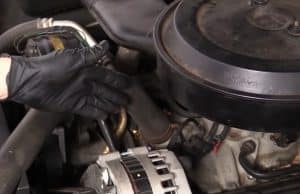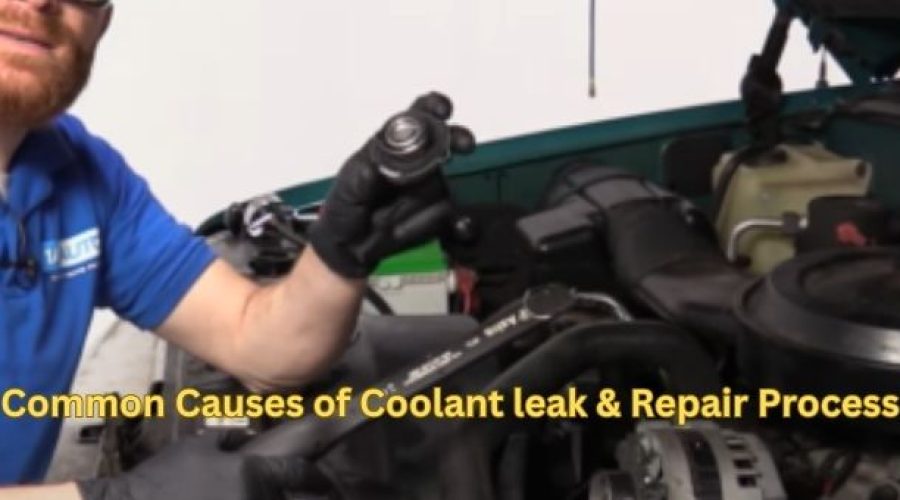When your car is leaking coolant, it can have severe problems. That’s why you need to understand its symptom. Because a leaky radiator may look like just a minor annoyance at first. But your car won’t run correctly when a coolant leak becomes a significant issue.
If the issue isn’t corrected soon, you could end up with engine failure and an expensive repair bill. Thankfully, if your radiator is leaking coolant, you can do several things to stop the leaks. Today I would like to share with you the details about it. So let’s go!
What is a Coolant leak?
Coolant is a crucial component of your vehicle’s engine. It contains antifreeze and a mixture of water and is the driving force behind the cooling mechanism. Without it, your vehicle could overheat and malfunction when seasons change, significantly reducing its lifespan.

A coolant leak can happen for many reasons, including a loosened hose clamp, a faulty head gasket, a damaged radiator hose, or a displaced foreign object kicked up by the truck in front of you penetrating the radiator itself. The resulting cascade of fluid can overheat your engine, warp your head, contaminate your oil, and cause your truck to stop.
What Are The Common causes of a Coolant leak?
Here are a few common causes for you:
1. Hole In The Radiator

The reasons for a coolant leak can vary. However, it’s usually caused by a hole in the radiator, commonly caused by debris from road debris, or even a stone kicked up from a passing vehicle.
It can cause coolant to leak out of the radiator and onto your engine block and freeze on cold nights. It’s not uncommon for the freeze to crack your engine block or cylinder head.
2. Your Head Gasket Is Blown
A blown head gasket can cause coolant to leak out of your vehicle. This is a pretty common problem in older vehicles, especially those that have been driven hard and put away wet.
There are two main types of coolant leaks, external and internal. External leaks are the easiest to repair because they occur at no more than a 90-degree angle with the vehicle’s body. For example, if you notice a puddle of coolant under your truck after you park it on a hot day, you could have an external leak.
3. You Have A Problem With Your Expansion Tank
It is the radiator’s most crucial component. It contains coolant and various metals, such as aluminum and steel. Like any other metal, it can get worn out from the high temperatures that it works. If your expansion tank has been damaged, you may notice puddles of coolant on the ground or a small leak in your radiator hose.
4. Your Water Pump Has Failed
The water pump is contained within the engine and is responsible for cooling the water. It essentially works as an electric fan, but instead of moving air, it pushes coolant. If your pump stops working, you’ll notice a small leak in your radiator hose or driveway.
How To Repair a Coolant Leak?

If you can isolate the area where the leak is coming from, try to fix the problem with the ways below. Common Causes of Coolant leak
Fix The Egg
Allow the car to leave and cool for 10 minutes. Open the hood and unscrew the radiator’s cap. Detach and pour two spare eggs into the radiator tank. Check to see if the leak ceased. If it did, you’re good to go. If not, insert a few more spare eggs into the radiator until the leak stops.
Replace Old Hose Clamps
Allow the automobile to cool down for at least 5 to 10 minutes. Pop the hood and unscrew the radiator cap. Identify the damaged or worn hose clamp if it’s still there.
Based on the place the cracked hose clamp is, you may need to drain some antifreeze. Place a bucket underneath the hose and empty as much as required to extract the hose clamp.
Try to repair old or damaged radiator hose clamps. Slide in a brand-new hose clamp onto the loosened hose. Tighten the hose clamp. Burn through radiator fluid and tighten the radiator cap.
Increase your car’s temperature and open the hood. Turn on the engine and check that the new hose clamp is free of leaks. Everything should be okay if everything looks good.
Replace Radiator Hose
Let the vehicle for ten minutes to cool and settle on the rack. Turn off the radiator, crank the hood down, and disconnect the radiator hose. Check the hose for damage and decide if the hose requires coolant draining.
Clear the area behind the fluid-discharging receptacle. Unfasten the hose clamps on the opposite side of the hose.
Put the hose clamps on the hose at both ends of the hose. Tighten both hose clamps. Fill the radiator with new fluid and tighten the radiator cap.
Please turn on the car and let warming up do its work. Then inspect the location of the new hose for leaks. If there is any leak, tighten the hose clamps.
Replace a Radiator
Please turn off the vehicle and allow it to cool for five to ten minutes. Disconnect the battery, and drain any remnants of coolant from your vehicle’s radiator safely.
Once drained, unhook the remainder of the hoses from your radiator and engine. Remove the old radiator thermostat.
Find the bracketry supporting the blower pod and open the air conditioner’s bottom compartment. Set the blower pod on top and open the air conditioner’s top compartment. Install the bottom rotary panel of the air conditioner before operating it.
Remove the tape from the new hose connected to the previous thermostat and connect it to the brand-new one. Reconnect all hoses to the new radiator. Refill the new radiator with fluid. Reconnect the battery.
Start the car with the radiator cap off. If everything looks good and your car s temperature stays even congrats, you did it!
FAQs
How much do coolant leaks cost to fix?
If your truck’s cooling system begins to leak coolant, you could spend about $1,00 for a repair. A radiator leak is usually the most costly repair for a cooling system.
Can you drive a car with a coolant leak?
It’s safer not to drive once your car’s coolant leaks since it raises the danger of a potential fire inside the engine.
Final Discussion
Maintaining your vehicle’s cooling system is crucial to ensure its longevity. However, it’s not enough to have the radiator changed. You also need to change the fluids and ensure that everything else is in good condition.
OBD II codes can help you identify problems that you may have with your car’s engine cooling system. Don’t forget that you’ll also need to check your engine hoses for leaks and replace them if necessary.

